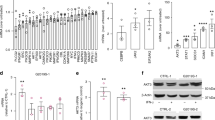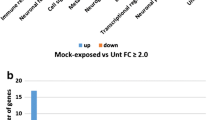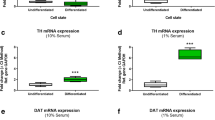Abstract
Despite extensive efforts to study the inflammatory process in the central nervous system of Parkinson’s disease (PD) patients, little is known about the role of peripheral blood mononuclear cells (PBMCs) in PD. In the present study, we used an in vitro co-culture system to study the role of the human monocyte cell line THP-1 in medium conditioned by the neuroblastoma cell line SH-SY5Y damaged with the endogenous neurotoxin 1-methyl-4-phenyl-1,2,3,4-tetrahydroisoquinoline (Salsolinol, Sal) in co-culture with the human glioma cell line U87. For this purpose, SH-SY5Y and U87 co-cultures were treated with Sal, and this conditioned medium containing mediators, including the potential effector CCL2, was isolated and applied to THP-1 cells. This treatment resulted in approximately 19 % cell proliferation as well as activation of mTOR and induction of phosphorylated 4E-BP1, S6K1, PI3K, and AKT proteins. Treatment with rapamycin, an mTOR inhibitor, attenuated the proliferation of THP-1 cells. U87 glial cells were essential for this as medium conditioned without them had no effect on THP-1 cells. These results suggest a positive effect of THP-1 cells on Sal-induced neurotoxicity in a cellular model of PD and this is likely mediated by the enhancement of cell proliferation through activation of the mTOR signaling pathway. Hence, PBMCs and their mTOR signaling pathway could be of therapeutic benefit in treating the endogenous neurotoxin-induced neuroinflammation in PD.




Similar content being viewed by others
Abbreviations
- PD:
-
Parkinson’s disease
- MPTP:
-
1-Methyl-4-phenyl-1,2,3,6-tetrahydropyridine
- Sal:
-
Salsolinol, 1-methyl-4-phenyl-1,2,3,4-tetrahydroisoquinoline
- NMSal:
-
N-Methyl-salsolinol, 1,2(N)-dimethyl-6,7-dihydroxy-1,2,3,4-tetrahydroisoquinoline
- SNpc:
-
Substantia nigra pars compacta
- FBS:
-
Fetal bovine serum
References
Samii A, Nutt JG, Ransom BR (2004) Parkinson’s disease. Lancet 363(9423):1783–1793
Lesage S, Brice A (2009) Parkinson’s disease: from monogenic forms to genetic susceptibility factors. Hum Mol Genet 18(R1):R48–R59
Gelb DJ, Oliver E, Gilman S (1999) Diagnostic criteria for Parkinson disease. Arch Neurol 56(1):33–39
Davis GC, Williams AC, Markey SP, Ebert MH, Caine ED, Reichert CM, Kopin IJ (1979) Chronic Parkinsonism secondary to intravenous injection of meperidine analogues. Psychiatry Res 1(3):249–254
Ballard PA, Tetrud JW, Langston JW (1985) Permanent human parkinsonism due to 1-methyl-4-phenyl-1,2,3,6-tetrahydropyridine (MPTP): seven cases. Neurology 35(7):949–956
Bove J, Perier C (2012) Neurotoxin-based models of Parkinson’s disease. Neuroscience 211:51–76
Mravec B (2006) Salsolinol, a derivate of dopamine, is a possible modulator of catecholaminergic transmission: a review of recent developments. Physiol Res/Academia Scientiarum Bohemoslovaca 55(4):353–364
Pisani V, Stefani A, Pierantozzi M, Natoli S, Stanzione P, Franciotta D, Pisani A (2012) Increased blood-cerebrospinal fluid transfer of albumin in advanced Parkinson’s disease. J Neuroinflammation 9:188
McGeer PL, Itagaki S, McGeer EG (1988) Expression of the histocompatibility glycoprotein HLA-DR in neurological disease. Acta Neuropathol 76(6):550–557
Kannarkat GT, Boss JM, Tansey MG (2013) The role of innate and adaptive immunity in Parkinson’s disease. J Parkinson’s Dis 3(4):493–514
Amor S, Woodroofe MN (2014) Innate and adaptive immune responses in neurodegeneration and repair. Immunology 141(3):287–291
Mount MP, Lira A, Grimes D, Smith PD, Faucher S, Slack R, Anisman H, Hayley S, Park DS (2007) Involvement of interferon-gamma in microglial-mediated loss of dopaminergic neurons. J Neurosci Off J Soc Neurosci 27(12):3328–3337
Mogi M, Harada M, Kondo T, Riederer P, Inagaki H, Minami M, Nagatsu T (1994) Interleukin-1 beta, interleukin-6, epidermal growth factor and transforming growth factor-alpha are elevated in the brain from parkinsonian patients. Neurosci Lett 180(2):147–150
Blum-Degen D, Muller T, Kuhn W, Gerlach M, Przuntek H, Riederer P (1995) Interleukin-1 beta and interleukin-6 are elevated in the cerebrospinal fluid of Alzheimer’s and de novo Parkinson’s disease patients. Neurosci Lett 202(1–2):17–20
Koziorowski D, Tomasiuk R, Szlufik S, Friedman A (2012) Inflammatory cytokines and NT-proCNP in Parkinson’s disease patients. Cytokine 60(3):762–766
Funk N, Wieghofer P, Grimm S, Schaefer R, Buhring HJ, Gasser T, Biskup S (2013) Characterization of peripheral hematopoietic stem cells and monocytes in Parkinson’s disease. Mov Disord Off J Mov Disord Soc 28(3):392–395
Deleidi M, Gasser T (2013) The role of inflammation in sporadic and familial Parkinson’s disease. Cell Mol Life Sci (CMLS) 70(22):4259–4273
Saunders RN, Metcalfe MS, Nicholson ML (2001) Rapamycin in transplantation: a review of the evidence. Kidney Int 59(1):3–16
Ullrich C, Mlekusch R, Kuschnig A, Marksteiner J, Humpel C (2010) Ubiquitin enzymes, ubiquitin and proteasome activity in blood mononuclear cells of MCI, Alzheimer and Parkinson patients. Curr Alzheimer Res 7(6):549–555
Prigione A, Begni B, Galbussera A, Beretta S, Brighina L, Garofalo R, Andreoni S, Piolti R, Ferrarese C (2006) Oxidative stress in peripheral blood mononuclear cells from patients with Parkinson’s disease: negative correlation with levodopa dosage. Neurobiol Dis 23(1):36–43
Colombo C, Cosentino M, Marino F, Rasini E, Ossola M, Blandini F, Mangiagalli A, Samuele A, Ferrari M, Bombelli R et al (2003) Dopaminergic modulation of apoptosis in human peripheral blood mononuclear cells: possible relevance for Parkinson’s disease. Ann N Y Acad Sci 1010:679–682
Gardai SJ, Mao W, Schule B, Babcock M, Schoebel S, Lorenzana C, Alexander J, Kim S, Glick H, Hilton K et al (2013) Elevated alpha-synuclein impairs innate immune cell function and provides a potential peripheral biomarker for Parkinson’s disease. PLoS ONE 8(8):e71634
Grozdanov V, Bliederhaeuser C, Ruf WP, Roth V, Fundel-Clemens K, Zondler L, Brenner D, Martin-Villalba A, Hengerer B, Kassubek J et al (2014) Inflammatory dysregulation of blood monocytes in Parkinson’s disease patients. Acta Neuropathol 128(5):651–663
Djukic M, Mildner A, Schmidt H, Czesnik D, Bruck W, Priller J, Nau R, Prinz M (2006) Circulating monocytes engraft in the brain, differentiate into microglia and contribute to the pathology following meningitis in mice. Brain J Neurol 129(Pt 9):2394–2403
Naoi M, Maruyama W, Nagy GM (2004) Dopamine-derived salsolinol derivatives as endogenous monoamine oxidase inhibitors: occurrence, metabolism and function in human brains. Neurotoxicology 25(1–2):193–204
Naoi M, Maruyama W, Akao Y, Yi H (2002) Dopamine-derived endogenous N-methyl-(R)-salsolinol: its role in Parkinson’s disease. Neurotoxicol Teratol 24(5):579–591
Thomas MG, Saldanha M, Mistry RJ, Dexter DT, Ramsden DB, Parsons RB (2013) Nicotinamide N-methyltransferase expression in SH-SY5Y neuroblastoma and N27 mesencephalic neurones induces changes in cell morphology via ephrin-B2 and Akt signalling. Cell Death Dis 4:e669
Wang F, Awan UF, Wang Y, Wang L, Qing H, Ma H, Deng Y (2014) Damage of neuroblastoma cell SH-SY5Y mediated by MPP + inhibits proliferation of T-cell leukemia Jurkat by co-culture system. Int J Mol Sci 15(6):10738–10750
Kaler P, Augenlicht L, Klampfer L (2009) Macrophage-derived IL-1beta stimulates Wnt signaling and growth of colon cancer cells: a crosstalk interrupted by vitamin D3. Oncogene 28(44):3892–3902
Park DR, Thomsen AR, Frevert CW, Pham U, Skerrett SJ, Kiener PA, Liles WC (2003) Fas (CD95) induces proinflammatory cytokine responses by human monocytes and monocyte-derived macrophages. J Immunol 170(12):6209–6216
Weichhart T (2012) Mammalian target of rapamycin: a signaling kinase for every aspect of cellular life. Methods Mol Biol 821:1–14
Sarbassov DD, Ali SM, Sengupta S, Sheen JH, Hsu PP, Bagley AF, Markhard AL, Sabatini DM (2006) Prolonged rapamycin treatment inhibits mTORC2 assembly and Akt/PKB. Mol Cell 22(2):159–168
Hresko RC, Mueckler M (2005) mTOR.RICTOR is the Ser473 kinase for Akt/protein kinase B in 3T3-L1 adipocytes. J Biol Chem 280(49):40406–40416
Sarbassov DD, Guertin DA, Ali SM, Sabatini DM (2005) Phosphorylation and regulation of Akt/PKB by the rictor-mTOR complex. Science 307(5712):1098–1101
Elloso MM, Azrolan N, Sehgal SN, Hsu PL, Phiel KL, Kopec CA, Basso MD, Adelman SJ (2003) Protective effect of the immunosuppressant sirolimus against aortic atherosclerosis in apo E-deficient mice. Am J Transpl Off J Am Soc Transpl Am Soc Transpl Surg 3(5):562–569
Verheye S, Martinet W, Kockx MM, Knaapen MW, Salu K, Timmermans JP, Ellis JT, Kilpatrick DL, De Meyer GR (2007) Selective clearance of macrophages in atherosclerotic plaques by autophagy. J Am Coll Cardiol 49(6):706–715
Liu K, Shi N, Sun Y, Zhang T, Sun X (2013) Therapeutic effects of rapamycin on MPTP-induced Parkinsonism in mice. Neurochem Res 38(1):201–207
Acknowledgments
We thank the National Natural Science Foundation of China (No. 31200636) and the ministry of Science and Technology, China (No. 2012YQ040140) for their support. We acknowledge the support provided by the Laboratory for Bioseparation and Bioanalysis and members in the lab.
Conflict of interest
The authors declare no conflict of interest.
Author information
Authors and Affiliations
Corresponding author
Rights and permissions
About this article
Cite this article
Wang, F., Ni, J., Wang, X. et al. Salsolinol Damaged Neuroblastoma SH-SY5Y Cells Induce Proliferation of Human Monocyte THP-1 Cells Through the mTOR Pathway in a Co-culture System. Neurochem Res 40, 932–941 (2015). https://doi.org/10.1007/s11064-015-1547-8
Received:
Revised:
Accepted:
Published:
Issue Date:
DOI: https://doi.org/10.1007/s11064-015-1547-8




